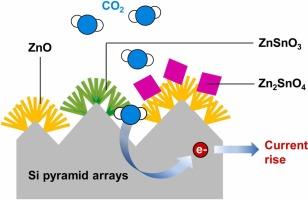Boosting CO2 sensitivity via multiphase ZnO heterojunctions and surface-engineered silicon pyramids
IF 3.7
1区 化学
Q1 CHEMISTRY, ANALYTICAL
引用次数: 0
Abstract
The development of low-temperature and high-sensitivity CO2 gas sensors is crucial for applications in environmental monitoring and indoor air quality control. In this study, we report a ZnO-based heterostructure sensor fabricated on silicon pyramid arrays to enhance CO2 detection performance. Vertically aligned ZnO nanorods were synthesized on etched Si substrates via hydrothermal methods, followed by the formation of ZnSnO3 and Zn2SnO4 heterostructures through corrosion and hydrothermal reactions. XRD and EDS analyses confirmed the formation of composite oxide phases, and energy band diagrams revealed favorable n–n type heterojunctions at the ZTO/ZnO interface. Five types of devices were systematically compared, with the ZnSnO3-ZnO and Zn2SnO4-ZnO sensors demonstrating high sensitivities of 365% and 398%, respectively, toward 2500 ppm CO2 at an optimal operating temperature of 150 °C. These sensors also exhibited excellent stability over 30 days, minimal cross-sensitivity to common interfering gases (ethanol, acetone, hydrogen), and reduced humidity interference under controlled relative humidity (20–80%). Compared with previously reported metal oxide sensors, the proposed structures offer superior sensitivity, fast response/recovery, and reliable low-temperature operation. This work presents a scalable and material-efficient strategy for the fabrication of selective and stable CO2 sensors suitable for real-world applications.

通过多相ZnO异质结和表面工程硅金字塔提高CO2敏感性
研制低温、高灵敏度的CO2气体传感器对于环境监测和室内空气质量控制具有重要意义。在这项研究中,我们报道了一种基于硅金字塔阵列的zno异质结构传感器,以提高二氧化碳的检测性能。通过水热法在蚀刻的Si衬底上合成了垂直排列的ZnO纳米棒,然后通过腐蚀和水热反应形成了ZnSnO3和Zn2SnO4异质结构。XRD和EDS分析证实了复合氧化物相的形成,能谱图显示了ZTO/ZnO界面上有利的n-n型异质结。系统比较了五种器件,ZnSnO3-ZnO和Zn2SnO4-ZnO传感器在150 °C的最佳工作温度下,对2500 ppm CO2的灵敏度分别达到365%和398%。这些传感器在30天内也表现出优异的稳定性,对常见干扰气体(乙醇,丙酮,氢气)的交叉灵敏度最小,并且在控制相对湿度(20-80%)下减少湿度干扰。与先前报道的金属氧化物传感器相比,所提出的结构具有更高的灵敏度、快速响应/恢复和可靠的低温操作。这项工作提出了一种可扩展和材料高效的策略,用于制造适合实际应用的选择性和稳定的二氧化碳传感器。
本文章由计算机程序翻译,如有差异,请以英文原文为准。
求助全文
约1分钟内获得全文
求助全文
来源期刊

Sensors and Actuators B: Chemical
工程技术-电化学
CiteScore
14.60
自引率
11.90%
发文量
1776
审稿时长
3.2 months
期刊介绍:
Sensors & Actuators, B: Chemical is an international journal focused on the research and development of chemical transducers. It covers chemical sensors and biosensors, chemical actuators, and analytical microsystems. The journal is interdisciplinary, aiming to publish original works showcasing substantial advancements beyond the current state of the art in these fields, with practical applicability to solving meaningful analytical problems. Review articles are accepted by invitation from an Editor of the journal.
 求助内容:
求助内容: 应助结果提醒方式:
应助结果提醒方式:


